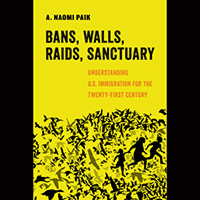
Naomi Paik, an Asian American studies professor at Illinois, lays out the long history behind current U.S. immigration policies in a new book.
Photo courtesy the Asian American studies department at Illinois
CHAMPAIGN, Ill. — U.S. immigration policies of recent years are praised by some and denounced by others, but there is plenty of history behind them that's often overlooked, says the author of a new book.
Going back to the nation's founding, there is a history of seeking to "exclude, contain and remove" people that often contradicts the welcoming "nation of immigrants" narrative, according to A. Naomi Paik, a professor of Asian American studies at the University of Illinois, Urbana-Champaign.
"That narrative of the nation of immigrants is very powerful, and it is very compelling to many people who are immigrants or who want to be immigrants," said Paik, herself a child of immigrants. "But even as the United States can be a nation of immigrants, it has also been something else entirely."

"Bans, Walls, Raids, Sanctuary: Understanding U.S. Immigration for the Twenty-First Century" is published by the University of California Press.
In her book "Bans, Walls, Raids, Sanctuary: Understanding U.S. Immigration for the Twenty-First Century," Paik places the roots of current immigration policies in a history of U.S. settlement that displaced Indigenous people, enslaved African-descended people and tried to exclude or contain specific immigrant groups.
Anyone who didn't fit within an ideal of American society, grounded in whiteness and property ownership, was subject to different forms of state repression, Paik said. "This recasting of history shows us how differently oppressed groups are actually very connected to each other."
Paik starts her respective chapters on bans, walls and raids by citing the executive orders on each that were issued during the opening days of the Trump administration. She then delves into their deep historical foundations and ties those historical roots to more-recent concerns such as mass incarceration and racialized policing.
Immigrant bans originated in the late 1800s, starting with Chinese women and working-class laborers banned through the Chinese Exclusion Acts, Paik said. The federal government then moved to exclude those deemed likely to become public charges, people with both physical and mental disabilities, and others. "It has massively expanded all these categories of people it considers undesirable," she said.
The origins of the so-called "Muslim ban" can also be traced to a much longer history of anti-Muslim and anti-Arab racism going back to earlier European colonialism preceding the United States, but also up through the present, especially following 9/11, Paik said.
The origins of the U.S.-Mexico border wall – which already covered 600 miles before Trump took office – can also be traced back to 19th-century efforts to block Asian immigrants, but which over time have focused on Mexican and other Latin American migrants, Paik said.
Beyond that, border enforcement has been driven largely by economics, she said. "We need to situate it always in relation to economic demands, especially for cheap labor. Part of our federal program definitely is an example of wanting the labor, but not the lives, of immigrants."
Raids to round up and remove immigrants also date back to the 1800s, Paik said, and the U.S. has deported more than 50 million people over its history – 95% of those since 1970.
This history shows, however, that bans and attempts to then remove banned populations ultimately don't work, Paik said. "We create these problems through our policies that are irresolvable, and so we get into a vicious cycle. It's a morass that we can't get ourselves out of because we have unrealistic assumptions about our policies."
"We have to acknowledge that the things that we've been doing don't work," Paik said. "You cannot stop migration at borders. That is one of the things that history tells us. So you have to address the root causes of migration."
Among those factors that drive people to migrate, she said, are a vastly unequal international economic system and foreign policies that result in poverty and violence. "Unless we really grapple with the messiness of these histories, we are not going to find real solutions."
Raids and other deportation efforts also have produced a threat beyond that to immigrants, Paik said. "The escalations of repressive policies and repressive policing practices that target immigrants actually threaten democratic processes for all of us," she said.
The "sanctuary" in Paik's book title refers to how she envisions a move toward solutions rooted in the broad concept of sanctuary and welcoming the stranger that go back millennia. In talking about "abolitionist sanctuary," she takes in aspects of U.S. history such as the Underground Railroad that aided people escaping slavery and also ties in current movements to abolish prisons and police.
"I really wanted to think about how we can use these movements to rethink our relationships to each other and not harm each other. Instead of demanding punitive forms of justice, we address these issues in a way that actually resolves the root causes and don't just put Band-Aids on them, while making those root conditions worse."






